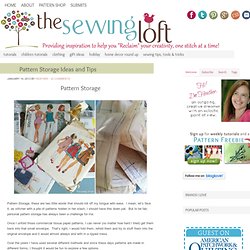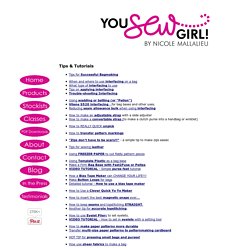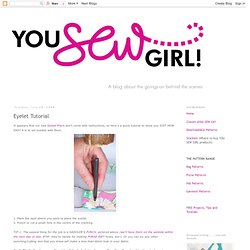

How to Print, Assemble and Trace PDF Sewing Patterns. There’s been an undeniable increase in PDF sewing patterns from independent companies in recent years, providing instant and affordable access to some seriously gorgeous designs.

Opinion remains largely divided; however, with some people favoring traditional paper patterns. Between Sizes? Use Finished Garment Measurement for a Perfect Fit. Getting the fit just right is by far the most challenging aspect of sewing clothing.

Let’s not mince words here: Fitting is hard. Every effort should be made to adjust patterns to address figure issues well before the first pattern piece is cut. That process begins by first selecting the right pattern size. If you are in between sizes, learn to use the finished garment measurements that appear on the back of the pattern envelope to help you zero into the right size. But, the “finished garment measurement”, or FGM, can help in other ways towards getting you to the right fitting garment.
Finished garment measurements (note that on some patterns they are referred to as just “garment measurements”) are the dimensions of the finished garment typically referenced at the bustline, waist and hip. Finished garment measurements for most commercial patterns appear on the back of the envelope at the bottom. 5 Uses for Bias Tape: The Duct Tape of the Sewing World. Bias tape is well known to quilters for finishing the edges of quilts, but bias tape is also a staple in garment sewing as well.

Bias tape can either be store-bought or made at home and comes it in a wide variety of solid colors and prints. You can custom make bias tape in nearly any thickness or fiber content. It’s been said that bias tape is the duct tape of the sewing world – you can use it for nearly everything! 1. How to Sew Double Welt Pockets: A Step-By-Step Tutorial! Double welt pockets are a classic addition to tailored garments such as pants, jackets and vests for both men and women.

They can even be sewn onto bags and button-down shirts for a unique touch. Double welt pockets require precise marking and stitching, which may seem intimidating, but the impressive result is worth the few extra steps during construction. There are a few ways to sew double welt pockets, but this is my favorite method because the welts are created from one piece of fabric. Light as a Feather: 5 Must-Have Tools for Sewing Delicate Fabric. Sweet summer time has arrived bringing with it warm weather and sunshine.

This also means many sewers are now devoting their time to creating airy, carefree garments made out of lightweight fabrics. Though highly desirable this time of year sewing, lightweight fabrics can sometimes be a challenge. We’re here to make it a snap. Lined Sheer T-shirt via Craftsy instructor Sara Alm from her class The Essential Guide to Sewing With Sheers Fabrics such as chiffon, charmeuse, georgette, voile, organza and many other lightweight materials, are notorious for being rather slippery and unstable, making them extremely difficult to sew.
As is often the case when it comes to sewing, having some essential sewing tools and knowing proper techniques can transform an unpleasantly difficult sewing experience into an enjoyably rewarding one. . #1: Serrated edge sewing shears. How to Sew Knit Fabrics: Sewing With Jersey 101. Babies love wearing cozy knits!

Ladies love wearing cozy knits! The Season of Cozy is upon us, but when we asked the Prudent Mamas, we discovered everyone is nervous about knits. We get that! Since we have a bunch of cute patterns for knit jersey dresses and such planned for you, we thought we’d start by getting everyone comfortable with sewing knits. Let’s start with a little primer, including what equipment you need (or don’t need), the different stitches, and some basic tips to help you get on your way to Cozytown. From the feedback on our facebook page and twitter, we see that the Prudent Mamas have concerns about stretched out seams, popping threads, and slippage while sewing.
How to Wash Fabric Before Sewing: Washing Various Fabrics. You just got back from a major fabric shopping spree, and are dying to get a few of your beautiful purchases cut out and sewn up as soon as possible.

If fabric could fit in your pocket, it would be the equivalent of money burning a hole in it! Round up of Pattern Storage Ideas. Pattern Storage, these are two little words that should roll off my tongue with ease.

Nicole Mallalieu Design - Tips and Tutorials for Making Bags and Purses. Tips & Tutorials Back to top VIDEO TUTORIAL - How to set in eyelets with a setting tool VIDEO TUTORIAL - Simple method for inserting purse feet.

Eyelet Tutorial. It appears that our new Eyelet Pliers don't come with instructions, so here's a quick tutorial to show you JUST HOW EASY it is to set eyelets with them. 1.

Mark the spot where you want to place the eyelet. 2. Punch or cut a small hole in the centre of the marking. Tip 2: It's better to err on the side of the hole being too small, rather than too big. 3. 4. TIP 3: Eyelets prefer a bit of thickness in the fabric. A shortcut within a shortcut inside a shortcut... I discovered years ago, that freezer paper was useful not only for cutting repeat shapes of fiddly applique designs, but also for cutting out small pattern pieces for bags and purses (and it's MAGIC with small bag bits on slippery lining fabrics).For the uninitiated, freezer paper has a shiny side and a dull side. When you iron the shiny side to the surface of fabric, it sticks. The magic bit is that you can then peel it off and RE-USE the freezer paper quite a few more times.
It'll eventually lose its stickiness, but it kicks on for longer than you'd think. I love a shortcut.... so when faced with the prospect of tracing Tania's HOT FROG pattern pieces onto freezer paper (a fiddly pattern piece always has me reaching for the freezer paper), I thought of yet ANOTHER shortcut. How to sew a pocket zipper. I only recently started installing zippers this way but i think i like it; it can be really useful for making wallets and bags. first start by applying interfacing to the outer fabric where you will install the zipper. then mark a rectangle where you want the zipper to be. the zipper i used for this is 4" and i marked a rectangle that is 4"x0.5". then place the outer and lining fabric right sides together, and sew around the rectangle using a smaller stitch. then clip the inside of the rectangle get the corners as close to the stitches as you can without actually cutting them. flip inside out and press. then line up and pin your zipper in place, and top stitch all the way around.
How To: (Sewing 101) Box Corners. Boxing corners is a really useful technique for bag making. boxing the corners adds extra dimension to your bags making it seem larger and makes it easier to store more and larger items. it also helps flatten the bottom of the bag allowing it to sit upright more easily. there are 3 different ways to box corners, the first 2 are very similar and require you to box each side individual. first, start by marking a box in the corner you want to box, don't forget to include seam allowances. for the first method, cut out the corner once you've marked it. fold your fabric, right sides together, so that the adjacent sides of the square you cut are lined up. sew along that edges, backstitching at the beginning and end. for the second method, mark the corner as before but don't cut yet. fold the fabric as you did before and sew along your mark, backstitching at the beginning and end. then trim the excess fabric. projects using Method 1 or 2: -custom laptop sleeve.
Learn to Sew Series-How to Buy Fabric. This is the last pre-lesson in my Learn to Sew series. The series itself starts Monday, but before it does, let’s talk fabric. Or more specifically how to buy fabric. Sewing Dictionary with Pictures-Learn to Sew. If you are new around here please check out my Learn to Sew series AND my Sew Crazy Monthly Challenge. Both are great opportunities to improve your sewing skills or to learn how to sew! I know that learn to sew can be hard, so, I am creating a Sewing Dictionary with pictures to help you in your sewing journey. How to sew laminated fabric - Sew McCool. Shh...the secret of how to sew buttons by hand - Sew McCool. I know it’s something that seems so simple.
I mean, who doesn’t know how to sew buttons by hand, right? Button, needle, thread, scissors….stick the needle in the holes back and forth, and, poof, finished.